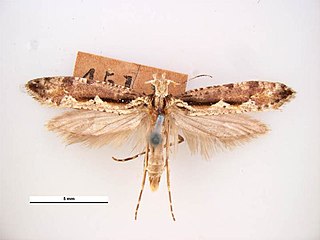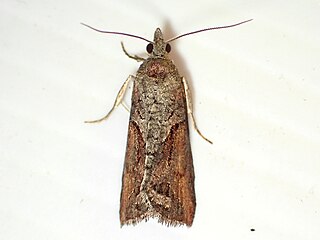Friseria is a genus of moths in the family Gelechiidae.

Thera variata, the spruce carpet, is a moth of the family Geometridae. It is found throughout Europe, North Asia and Japan. The common name spruce carpet is also used when referring to Thera britannica.

Aleimma loeflingiana is a moth of the family Tortricidae. It is found in Europe and the Near East.

Pseudoswammerdamia combinella is a moth of the family Yponomeutidae. It is found in Europe and Anatolia.

Bactra lancealana is a moth of the family Tortricidae found in Europe. The moth has a wingspan of 11–20 mm. The forewings are pale ochreous or ochreous- brownish, costa strigulated with darker ochreous or dark fuscous; a spot in disc at 1/3 and an angular mark beyond middle dark fuscous, often obsolete, sometimes forming a more or less complete dark median streak from base to apex; central fascia sometimes indicated on costa. Hindwings are grey. The larva is greenish or whitish-fleshcolour; head and plate of 2 black. It is very similar to Bactra furfurana.

Falcaria lacertinaria, the scalloped hook-tip, is a moth of the family Drepanidae. The species was first described by Carl Linnaeus in his 1758 10th edition of Systema Naturae It is found in Europe and Anatolia then east to Eastern Siberia.

Eulia ministrana is a moth of the family Tortricidae. It is found in the Palearctic and Nearctic realms.

Monochroa lucidella is a moth of the family Gelechiidae. It is found in most of Europe, except Spain, Switzerland and most of the Balkan Peninsula. It is recorded from the Near East and Siberia (Transbaikalia).

Hexadactilia trilobata is a moth of the family Pterophoridae described by Thomas Bainbrigge Fletcher in 1910. It is found in Australia in Queensland and New Guinea.

Sphenarches zanclistes is a moth of the family Pterophoridae that is found in Australia.
Batrachedra megalodoxa is a species of moth of the family Batrachedridae. It is found in Australia.

Rhigognostis annulatella is a moth of the family Plutellidae. It is found in most of Europe.

Cochylis hybridella is a moth species of the family Tortricidae. It is found in most of Europe, the Near East, China, Japan, Korea and Russia.
Ypsolopha maculatella is a moth of the family Ypsolophidae. It is known from the United States, including Arizona and California.

Maliattha signifera is a species of moth of the family Noctuidae first described by Francis Walker in 1858. It is found in south-east Asia, including China, India, Japan, Taiwan, Korea and Thailand as well as in Australia (Queensland).

Harmologa oblongana is a species of moth of the family Tortricidae. It is found in New Zealand.
Helcystogramma septella is a moth in the family Gelechiidae. It was described by Philipp Christoph Zeller in 1852. It is found in Malawi, South Africa, Tanzania and the Gambia.
Friseria caieta is a moth of the family Gelechiidae. It is found in North America, where it has been recorded from Arizona.
Friseria nona is a moth of the family Gelechiidae. It is found in North America, where it has been recorded from Arizona.
Friseria flammulella is a moth of the family Gelechiidae. It is found on the U.S. Virgin Islands, where it has been recorded from Saint Thomas.












